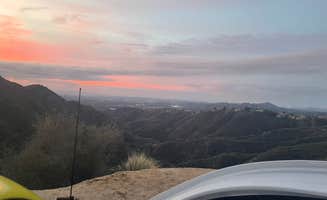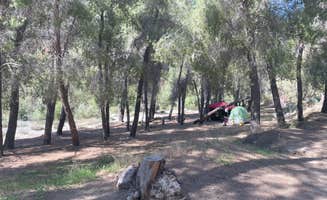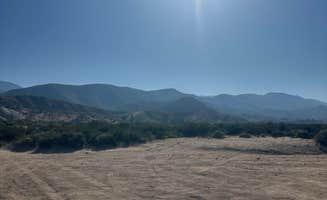Dispersed camping options in the Angeles National Forest provide rustic camping near Whittier, California with minimal amenities. The terrain features steep mountain roads and limited accessibility for larger vehicles. Most sites are positioned along forest roads at elevations ranging from 1,500 to 5,000 feet, creating significant temperature variations between seasons. Free primitive camping spots typically have 14-day stay limits throughout the national forest.
What to do
Explore informal parking spots: Hare School Park offers overnight parking for RVs without designated camping areas. "I've been here for a couple days and nobody's mess with us. There's other people that are staying in another parking lot attached that are homeless in their vehicles mostly cars and vans," reports Rockstar C. The area includes a dog park with a large field for pets.
Watch for changing forest regulations: When planning backcountry camping trips, check current Angeles National Forest fire restrictions and camping regulations before departing. Road conditions change seasonally, with many routes requiring high-clearance vehicles.
Enjoy morning views: The mountain overlooks provide expansive vistas of the Los Angeles basin. One camper at Angeles Crest Overlook noted, "The view is gorgeous in the morning sunrise!" The vista points attract both overnight vehicle campers and day visitors throughout the evening hours.
What campers like
Quick accessibility: Rim of the World Byway Dispersed provides convenient overnight parking directly off major routes. Alexander B. shared, "We stayed here for two nights, and it was a pretty pleasant experience! There were some cars parked near the entrance, but if you go a bit further down alongside the road you can find some nice spots."
Offroad adventure: Stockton Flats Yellow Post Sites attract 4x4 enthusiasts seeking remote camping. "Trail was fun (definitely needed 4x4) and the sites around has good shade and good size open spots. Best to get there early as possible to secure a spot," advises Panda V., highlighting the competitive nature of securing these primitive sites.
Isolation options: Remote pullouts along forest roads provide alternatives to main overlooks. Nicole D. explains, "There is a pull off before this that was very quiet near a trail and nobody bothered us. During the week it's more quiet." Weekday visits typically offer significantly less traffic and noise than weekends.
What you should know
Vehicle selection matters: Many dispersed sites require appropriate transportation. At Stockton Flats, Joe R. warns, "We decided not to go to the site because it looked like a one lane road and too tight for our 35 ft bumper pull." Forest roads frequently lack turnaround areas for larger vehicles.
Noise considerations: Angeles Crest Overlook experiences significant nighttime activity. "It did seem like maybe a teen hangout or something - cars did flow in and out occasionally through the night until around midnight," reports Valerie. Another camper, Iris A., observed "Some people stood silently admiring the view, while others played loud music."
Safety preparation: Cell service varies dramatically throughout the Angeles National Forest. Jaydon C. notes, "Unfortunately I didn't have any service (Visible/Verizon), so that was a little scary." Bring offline maps and emergency supplies when staying in remote locations.
Tips for camping with families
Consider alternatives: Dispersed camping near Whittier often lacks facilities families need. Andrew S. explains Angeles Crest Overlook "is literally just a roadside pull-off. Only really useful in a pinch. No space for a tent. Sleep in your vehicle." Most dispersed sites offer no flat tent spaces or safety barriers.
Pet-friendly options: Hare School Park provides urban camping with dog-friendly areas. Julia G. confirms, "You can overnight park here with your RV without problems." The location offers trash cans but lacks restroom facilities.
Trail access: Some dispersed areas connect to hiking trails. Nathaniel C. recommends, "If you go the the end of 3N06 (main off-road path) there is a good hike that you can take for several hours." Plan day activities from your basecamp to maximize the primitive camping experience.
Tips from RVers
Parking orientation: At Rim of the World Byway, Gregg P. advises, "If your headed north on I15 do not take thirst access road. Almost a 4x4 road." He adds, "I wanted a place where I could let Bella off leash, so I put it in 4 wheel drive to pull my TAB trailer. Found a good spot. I can see other bigger rigs they did not require 4x4."
Access planning: Joe R. recommends careful navigation: "By Rim of the world scenic byway and mormon rocks. Easy in and out but next to train tracks." Environmental noise factors like nearby train tracks affect sleep quality at many accessible dispersed sites.
Brake management: Mountain driving requires vehicle preparation. Joe R. cautions about steep terrain: "On the way back down from the turnaround we almost burned out our brakes." Descend slowly and use engine braking when possible on forest roads.





